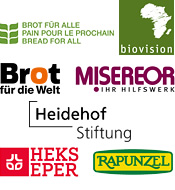A natural way of controlling pests: the Push-Pull method in Ethiopia
The main sources of income for small-scale farmers in the Tolay region in the southwest of Ethiopia are cereal growing and livestock production. However, many farmers are facing numerous problems presently. Alongside depleted soils, they also have to wage a fight against two dangerous enemies: the stem borer moth and the striga weed. The stem borer moth lays its eggs on maize and sorghum plants; the larvae then bore into the plant’s stem, eating it from the inside. Striga is a parasitic weed that penetrates the maize roots, drawing nutrients and water from the plant. If stem borers and striga occur together, they can cause huge crop losses – with fatal consequences for a region such as Tolay, where many live below the poverty line.
The Push-Pull method helps to defeat both enemies. The leguminous plant desmodium is planted in between the rows of maize or sorghum. It then suppresses the growth of the striga weed by natural means – as opposed to the patented alternative of chemical company BASF, which offers hybrid maize varieties resistant to Imazapyr, a herbicide (StrigAway®) that kills the striga seed as it germinates. The smell of desmodium repels the stem borer moths and drives them away from the main crop (push). Around the fields, the farmers plant napier grass, which attracts female stem borer moths (pull). They place their eggs in the grass where, once they try to bore into the grass, the hatched larvae die in the sticky substance the grass produces. Soils and livestock also benefit from Push-Pull. Like other leguminous plants, desmodium fixes nitrogen from the air with its root nodules. Its organic matter and the animals’ manure can then be composted and used to boost soil fertility. The napier grass serves as a highly nutritious extra fodder for the cattle that increases milk production. Farmers can also generate an additional income by selling the remaining grass.
Push-Pull was developed in the 1990s by scientists around Professor Khan at the International Centre of Insect Physiology and Ecology (icipe) in Kenya, in collaboration with farmers. In 1995, Hans Herren, then Director General of the icipe, was awarded the World Food Prize for leading a biological pest control campaign in Africa, successfully fighting the cassava mealybug – one of the reasons he was later appointed Co-chair of the IAASTD. His Biovision Foundation helps to spread the Push-Pull method from farm to farm. The method has proven successful and has been adopted by more than 130,000 farmers in East Africa.
In order to introduce the Push-Pull technique in Tolay, icipe is closely cooperating with the Ethiopian Institute of Agricultural Research. In 2013, the first trial fields were planted. Since then, almost 200 “demonstration farmers” and 18 agricultural advisers in and around Tolay have been trained to use and disseminate Push-Pull. Scientists are monitoring progress to be able to adapt the method to the local conditions. In East Africa, a new desmodium species has been introduced which is more drought-tolerant.









